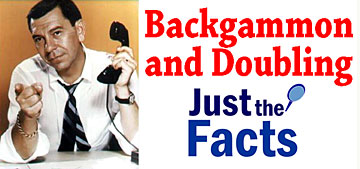 |
||||||||||||||||||||||||||||||||||||||
|
BACKGAMMON AND THE DOUBLING CUBE -- JUST THE FACTS by Bill Davis
|
||||||||||||||||||||||||||||||||||||||
| A person could dedicate his entire life studying the history of backgammon. Much has been written about the game over the years. But there is one historical backgammon topic that remains for the most part, a mystery: the introduction of doubling and the invention of the doubling cube.
David Levy, in a 2003 GammOnLine forum discussion, references Francis Willughby’s Book of Games: a 17th Century Treatise on Sports, Games, and Pastimes (ca 1660 in England), edited by David Cram, Jeffrey L. Forgeng and Dorothy Johnston, and published by Ashgate in 2003. In “Ticktack,” one of the described backgammon-like games, doubling the stakes is part of the rules. The term “vie” means to double. If a player accepts the double, he says “I see it.” Otherwise, he can yield the game. The big difference is that only the initial “vie” doubles the stakes. Future “vies” in the same game triple and next quadruple the stakes. But that is ancient history and doesn’t relate directly to our game. Permitting players to optionally double and redouble the stakes prior to rolling was responsible for backgammon’s resurgence in the United States (and later across the globe) from about 1927 into the 1930s. Over the past two years, CHICAGO POINT has collected a treasure trove of backgammon doubling information from old newspapers, magazines, and books. Special thanks to Ed Bennett (who made a trip to the New York City Racquet & Tennis Club and interviewed the older players), Ken Bame, Chris Bray, Frank Frigo, Kathleen Davis, David Levy, Maurice Barie, Vic Morawski, and Grant Schneider for their help in this project. Let us first list all of the facts we know regarding doubling and the cube. (There are underlined links to the most important referenced information.) Eventually, we will analyze the known information and make our best guess on what we really know. In the meantime, IF YOU CAN PROVIDE AN EARLIER REFERENCE FOR ANY OF THE MATERIAL SHOWN BELOW, PLEASE E-MAIL US.—Bill Davis For more an important article on the origin of Doubling (discovered by Frank Frigo), read THIS. . The most commonly quoted year for the introduction of doubling into backgammon is 1925. The following writers/publications reference that year: 1. George Mead Rushmore, Racquet & Tennis Club: Some History and Some Memories (1964), page 92. [View article] 2. National Geographic Society wire service, “Backgammon Hits It Big,” New Castle (PA) News (June 6, 1973). 3. Mike Goodman, “Backgammon Hustlers--And How They Do It,” Los Angeles (CA) Times (January 26, 1975). 4. Jacqueline Smith, “Oldest Game in History Earns Popularity in U.S. And Gains Followers Here,” Naples (FL) Daily News (April 4, 1976). Note that all of the articles published in the 1970s might have used the 1964 Rushmore article as their reference. . These men are credited with introducing the concept of doubling: 1. GRAND DUKE DMITRI (PAVLOVICH) credited by Charles Cooke, “The Talk of the Town," New Yorker (Sept. 6, 1930), pp. 12-13 [View Article]. Also credited by John Longacre, “To Double or Not to Double,” Vanity Fair (July 1931), page 52. [View Article] |
||||||||||||||||||||||||||||||||||||||
 |
||||||||||||||||||||||||||||||||||||||
| (L) Coco Chanel & Grand Duke Dmitri--circa 1921. (R) Grand Duke Dmitri, son Paul, and wife Audrey Emery--Nov. 1931. | ||||||||||||||||||||||||||||||||||||||
2. JACK WEMPLE credited by George Mead Rushmore, Racquet & Tennis Club: Some History and Some Memories (1964), page 92. [View Article]
An article in the October 1931 Harper's Bazaar magazine sheds additional light on the introduction of doubling: The October 1931 Harper's Bazaar magazine, page 171 [View article] offers the most thorough investgation into how doubling in backgammon came about. The article titled "The Backgammon Boom" by Walter L. Richard discussed how the introdution of doubling and chouette play was fueling a rapid increase in the game's popularity throughout the United States "over the past two years." According to other respected backgammon figures of that era, Walter L. Richard was considered a very thorough and trustworthy individual. Harold Thorne (author of Backgammon in Twenty Minutes and Backgammon Tactics) called him “...the deepest student the game has yet known.” Lelia Hattersley (author, How To Play The New Backgammon and Backgammon To Win) said about Mr. Richard’s methods, “…intuition is set aside in favor of precise knowledge.” A brief biography of Richard appears on the back of the dust cover of his Complete Backgammon (v1940), first published in 1931. [View Walter L. Richard biography] We don’t know anything other than what we have read about Walter L. Richard. However, based on that alone, we believe Mr. Richard to have been a reputable man with no agenda other than to provide the most accurate historical doubling information possible based on what was known in 1931. The following information can be extracted from Mr. Richard’s October 1931 Harper’s Bazaar article: 1. It is impossible to say who definitely originated doubling. Jean Nicolopoulo, described in 1930 as an outstanding backgammon enthusiast of the Travellers Club (Paris), said doubling was employed for years in the East before being tried in Occidental countries. 2. The first use of doubling in Europe (automatic or during play) originated in a game played in Paris in 1926 between The Grand Duke Dmitri of Russia and Aksel de Wichfeld of Denmark. Those two players reported that to them, their idea of doubling was original. 3. Messrs. Dmitri and Wichfeld induced other players at the Paris Travellers Club to adapt doubling and in about 1928, some Travellers Club players went to New York and introduced it to the Racquet and Tennis Club of New York City. Some of the friends of John P. Wemple declared that he was the first to show the new feature to them. Mentioning Mr. Wemple makes sense as the book Racquet & Tennis Club: Some History and Some Memories (1964) by George Meade Rushmore credits him with introducing doubling into the Racquet and Tennis Club. Mr. Rushmore believes the introduction occurred in 1925, but Mr. Richard writes that doubling was introduced in 1928. 1928 cannot be correct because the 1928 edition of Modern Backgammon [see below] discusses the introduction of doubling (and chouettes). Since Modern Backgammon includes a foreword by author Grosvenor Nicholas dated January 4, 1928, the advent of doubling in the United States must have occured prior to 1928.
One man is credited with inventing the doubling cube: W. WHITEWRIGHT WATSON credited by John De St. Jorre, Racquet & Tennis Club: An Historical Report (2007), page 148. [View Article] |
||||||||||||||||||||||||||||||||||||||
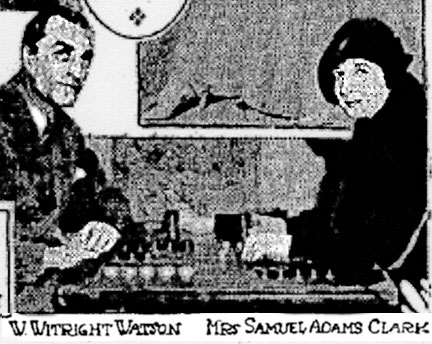 |
||||||||||||||||||||||||||||||||||||||
| W. Whitewright Watson playing backgammon at a 1931 winter charity party in Palm Beach, Florida. (Tyrone PA Daily Herald; Feb. 2, 1931) | ||||||||||||||||||||||||||||||||||||||
| Other references to the origin of doubling include:
1. Frank Crowninshield, “Bridge or Backgammon?” in Vogue (September 14, 1929), pp. 90 & 188. “It remained for a group of enthusiasts at the Racquet Club in New York to invent a further hazard in the shape of ‘matches and doubles.’” [View Article] 2. J. Van Cleft Cooper, “Learn Backgammon In 5 Minutes a Day” column in the Lowell (MA) Sun, (Oct. 3, 1930). “The doubling feature of bridge has been adapted to modern Backgammon." 3. Grosvenor Nicholas, Modern Backgammon (1928) p. 23. “It is said that the doubling, which has so greatly increased the possibilities of the game, as well as its popularity, was first originated on the continent of Europe in connection with the game of golf.” 4. National Geographic Society wire story, New Castle (PA) News (June 6, 1973) p. 17. “Backgammon’s rules were codified by England’s Edmond Hoyle in 1743 and remained virtually unchanged until 1925, when some unknown American invented the doubling cube.” 5. John Longacre, Backgammon of Today (1930), pp. 3-4. “The development and perfection of what may fairly be called -- in this country, at least -- the Backgammon of today, may be attributed to two New York clubs in which the game has been played intensively for over a generation.” 6. George Mead Rushmore, Racquet & Tennis Club: Some History and Some Memories (1964), page 92. “. . . at least one writer on the subject says it came from Scotland or England.” [View Article] 7. Oswald Jacoby & John R. Crawford, The Backgammon Book (1970), page 111. “We don’t know who first added the doubling feature to backgammon, but we feel we owe him a great debt.”
First written acknowledgment of doubling in backgammon: Grosvenor Nicholas, Modern Backgammon (1928), page 6. “It has remained for the Twentieth Century to further elaborate the game of backgammon, by the introduction of ‘doubling’ and ‘chouette’ and give us modern backgammon. This new game is gaining ground so rapidly that the sun seems destined again to shine upon dicing as it did in the time of the Caesars. Present circumstances are so propitious that we need consult no Cumean Sibyl or other augury to predict for modern backgammon and unprecedented popularity.” . First mentions of using matches to keep track of doubling: |
||||||||||||||||||||||||||||||||||||||
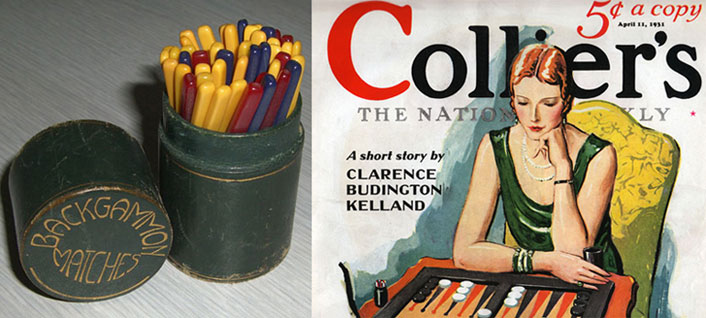 |
||||||||||||||||||||||||||||||||||||||
| (L) Backgammon matches (sometimes made of bakelite) were used for scoring prior to the doubling cube. (R) Collier's April 11, 1931 cover illustrated backgammon being played using a container of scoring matches. | ||||||||||||||||||||||||||||||||||||||
| 1. Frank Crowninshield, “Bridge or Backgammon” in Vogue (September 14, 1929), p. 90. “Backgammon, as a game, was a dead and discarded pastime relegated to old men in chimney corners until the practise of doubling---‘doubling by matches,’ as it is called---was injected into it . . .” [View Article]
2. Elizabeth Clark Boyden, The New Backgammon (Foreword dated June 5, 1930), page 34. “At present time, the popular method of counting the doubles is by the use of common matches.” 3. Lelia Hattersley, How To Play The New Backgammon (1930), p. 38. “In order to regulate and simplify all doubling and the matter of credits and losses, New York society has invented a very simple device of matches.” |
||||||||||||||||||||||||||||||||||||||
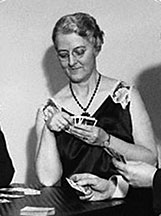 |
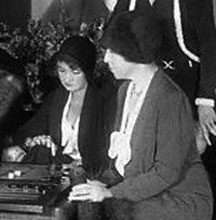 |
|||||||||||||||||||||||||||||||||||||
| Elizabeth Clark Boyden playing bridge in the 1930s. | Lelia Hattersley (R) teaching back-gammon circa early 1930s. | |||||||||||||||||||||||||||||||||||||
| Other early methods for keeping track of doubling in backgammon:
1. Scoring dial: |
||||||||||||||||||||||||||||||||||||||
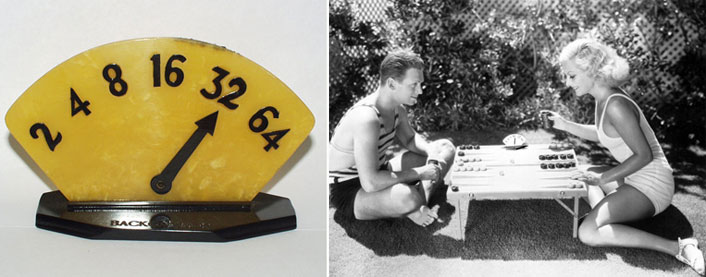 |
||||||||||||||||||||||||||||||||||||||
| (L) Scoring dial owned by Chris Bray. (R) Douglas Fairbanks, Jr. and Joan Crawford at their home in 1931 using a scoring dial to keep track of backgammon doubling. | ||||||||||||||||||||||||||||||||||||||
| 2. Peg board: | ||||||||||||||||||||||||||||||||||||||
 |
||||||||||||||||||||||||||||||||||||||
| (L) The peg board was another method used for scoring backgammon. (R) A couple scores their game with a peg board cruising on the Conte di Savoia passenger ship in the early 1930s. | ||||||||||||||||||||||||||||||||||||||
| First written mention of the doubling cube in backgammon:
1. Lelia Hattersley, How To Play The New Backgammon (1930), p. 39. “Many players, especially in Chouette, prefer to keep track of their doubles and the current stake with a device known as a doubling cube.” 2. Ralph A. Bond, Beginner’s Book of Modern Backgammon (October 1930), page 77. “The modern method of doubling is very simple. A cube, such as shown in the illustration below, is used.” |
||||||||||||||||||||||||||||||||||||||
 |
||||||||||||||||||||||||||||||||||||||
| Beginner's Book of Modern Backgammon by Ralph A. Bond was the first book to illustrate a doubling cube. | ||||||||||||||||||||||||||||||||||||||
| 3. Elizabeth Clark Boyden, “How To Play Today’s Backgammon,” in the Cumberland (MD) Evening Times, (Oct. 3, 1930). “Doubling cubes can now be purchased which eliminate the nuisances of matches. These cubes are about two inches square and are similar to dice except that they are numbered to correspond to the doubles as follows: 2, 4, 8, 16, 32, 64.”
. First two photographs of a doubling cube: 1. "America Goes Backgammon!" The Indianapolis Times (Sept. 22, 1930): |
||||||||||||||||||||||||||||||||||||||
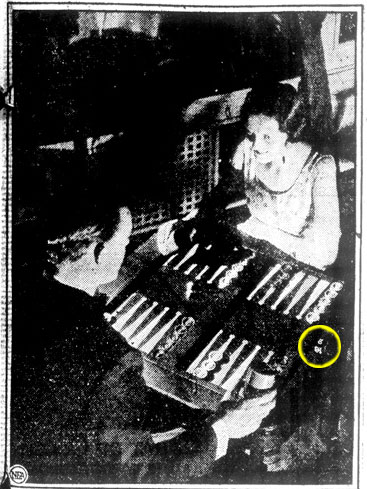 |
||||||||||||||||||||||||||||||||||||||
| The 1930 caption reads: "A swanky Chinese red leather-topped backgammon table may be converted into a bridge table simply by lifting out the backgammon board and turning it over." (Photo from A. G. Spalding and Bros.) | ||||||||||||||||||||||||||||||||||||||
| 2. Actress Miriam Hopkins in California (Picture taken Summer, 1931): | ||||||||||||||||||||||||||||||||||||||
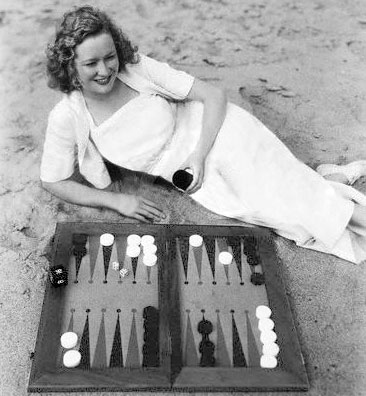 |
||||||||||||||||||||||||||||||||||||||
| The original 1931 caption reads: “When Miriam Hopkins completed her role opposite Maurice Chevalier in Paramount’s ‘The Smiling Lieutenant’ at Eastern Studios and was summoned to Hollywood to play a featured part in ‘24 Hours,’ she paused at her hotel just long enough to unpack her trunks, then hurried to the nearest Pacific coast beach.” | ||||||||||||||||||||||||||||||||||||||
| First advertisement for a doubling cube:
“Doubling Dice” selling for 25 cents at Miller & Paine Store, appeared in the newspaper The Lincoln (NE) Star (Nov. 18, 1930): |
||||||||||||||||||||||||||||||||||||||
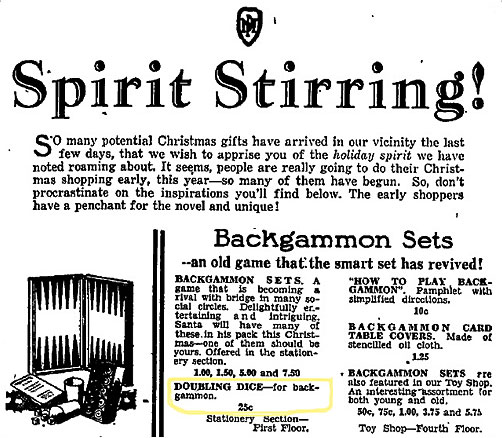 |
||||||||||||||||||||||||||||||||||||||
| A 1930 pre-Christmas advertisement for backgammon equipment including a doubling cube. | ||||||||||||||||||||||||||||||||||||||
| According to the following references, automatic doubles were devised after the invention of optional doubles:
1. Grosvenor Nicholas, Modern Backgammon (foreword dated Jan. 4, 1928), page 35. “Before concluding this chapter, we must mention one more recent development in connection with doubling. This is known as the automatic double. 2. Lelia Hattersley, How To Play The New Backgammon (1930), page 37. “A still more recent development of Backgammon is the additional form of doubling called the automatic double.” 3. Elizabeth Clark Boyden, “How To Play Today’s Backgammon,” newspaper column in the Frederick Post (Oct. 14, 1930). “In addition to these old friends [optional doubling, gammons, and backgammons] there now is a new form of automatic doubles, as follows: Whenever two players throw the same number, when they each cast one die to decide the opening move, they must throw again and the score is automatically doubled.” . First reference to a doubling cube with a ‘1” on it (instead of a 64): Prince Alexis Obolensky & Ted James. Backgammon: The Action Game (1969), page 140. “There are now doubling blocks manufactured that start with the number one.” [The late Larry Strommen of Indiana manufactured this type of doubling cube in the 1980s and 1990s.] |
||||||||||||||||||||||||||||||||||||||
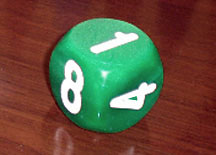 |
||||||||||||||||||||||||||||||||||||||
| The "64" has been replaced with a "1" on this type of doubling cube. | ||||||||||||||||||||||||||||||||||||||
| Other types of backgammon doubling cubes:
1. Half Cube: |
||||||||||||||||||||||||||||||||||||||
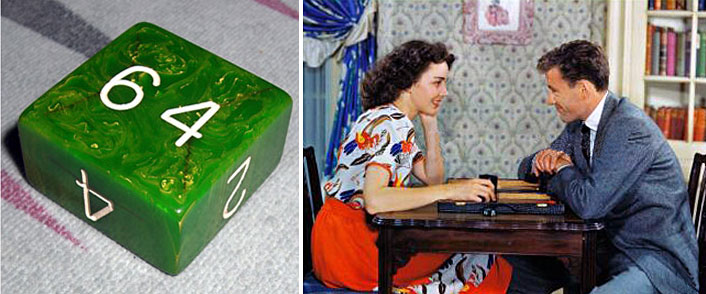 |
||||||||||||||||||||||||||||||||||||||
| (L) The late George Barr's doubling block that belonged to his father. (R) Married couple Jennifer Jones and Robert Walker play a game of backgammon in the early 1940s using a half cube. | ||||||||||||||||||||||||||||||||||||||
| 2. Deliberate Doubler (Logicube): | ||||||||||||||||||||||||||||||||||||||
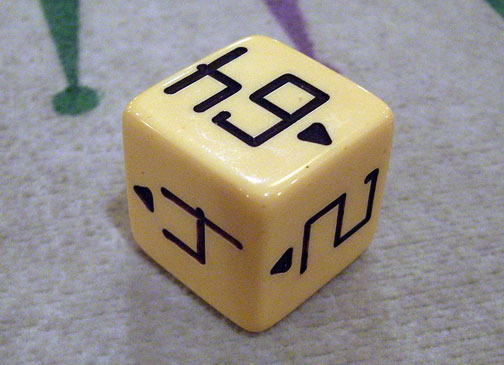 |
||||||||||||||||||||||||||||||||||||||
| Devised by Lawrence Sonne in the 1980s, each side of the doubler has an arrow that points to the next multiple of doubling -- 64 to 2 to 4 to 8, etc. (Larry Strommen sometimes referred to this doubler as a "logicube.") | ||||||||||||||||||||||||||||||||||||||
| Three newspaper column series taught backgammon to the masses and helped to popularize the game in the United States between September 1930 and April 1931:
1. “How To Play Today’s Backgammon” by Elizabeth Clark Boyden. |
||||||||||||||||||||||||||||||||||||||
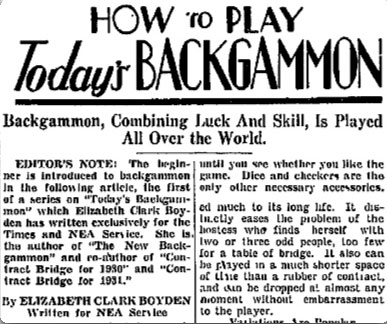 |
||||||||||||||||||||||||||||||||||||||
| 2. “Learn Backgammon in 5 Minutes a Day” by J. Van Cleft Cooper. | ||||||||||||||||||||||||||||||||||||||
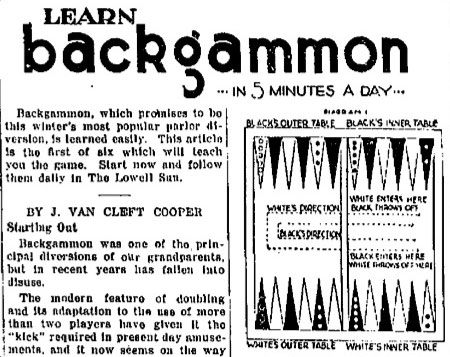 |
||||||||||||||||||||||||||||||||||||||
| 3. “Backgammon of Today” by John Longacre (reprints from his book of the same name). | ||||||||||||||||||||||||||||||||||||||
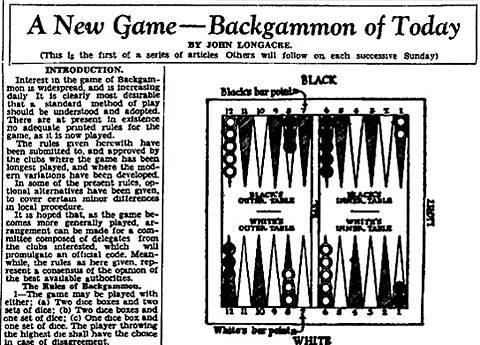 |
||||||||||||||||||||||||||||||||||||||
| Racquet & Tennis Club (New York City) list of Backgammon Champions: 1925-1955 (From Racquet & Tennis Club 1956 Club Book): | ||||||||||||||||||||||||||||||||||||||
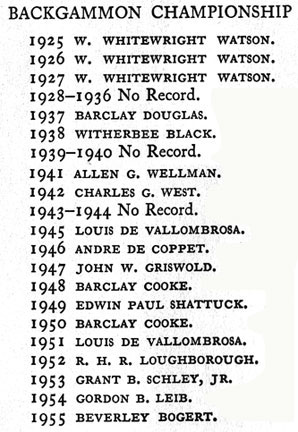 |
||||||||||||||||||||||||||||||||||||||
| Racquet & Tennis Club (New York City) backgammon-oriented members list with original membership year in parenthesis. From Racquet & Tennis Club 1932 and 1956 Club Books. Men's name with an asterisk * definitely had input into the 1931 Laws of Backgammon as prepared by the Racquet & Tennis Club. [In The Backgammon Book, page 199, Oswald Jacoby states that Wheaton Vaughn was the Laws organizer. The December 1981 Las Vegas Backgammon Magazine, p. 41, features an article by Oswald Jacoby (who was on the committee representing the Knickerbockerwhist Club). Jacoby writes that Walter Beinecke, Phil Randolph, and Grosvenor Nicholas were also on the committee. Therefore, names with an asterisk * were definitely on the committee.]
*Walter Beinecke |
||||||||||||||||||||||||||||||||||||||